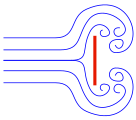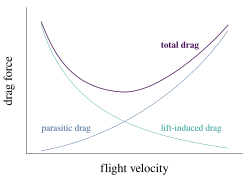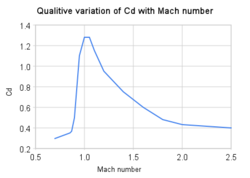Drag (physics)
In fluid dynamics, drag (sometimes called resistance) is a force which tends to slow the movement of an object through a liquid or gas. As a moving object pushes the liquid or gas out of its way, the fluid pushes back on the object. This drag force is always opposite to the object's motion, and unlike friction between solid surfaces, the drag force increases as the object moves faster.
Air resistance, also known as drag, is a force that is caused by air, the force acts in the opposite direction to an object moving through the air. It is where air particles hit the front of the object slowing it down. The more surface area, the more air particles hit it and the greater the resistance.
Things are often shaped to make less drag. That's called streamlining. For example, a truck with a flat front will experience high air resistance while a sports car with a curved shape will experience lower air resistance, allowing the car to go faster; because the air has less surface area to push against and therefore moves more smoothly across it. This is why airplanes and other fast machines are streamlined, and the same is true of fish. A snowflake falls more slowly than does a drop of water of the same weight.[1]
Drag can affect the quickest falling speed (the terminal velocity) of an object. The higher the drag, the slower the object falls.
Drag (physics) Media
Drag coefficient Cd for a sphere as a function of Reynolds number Re, as obtained from laboratory experiments. The dark line is for a sphere with a smooth surface, while the lighter line is for the case of a rough surface.
Explanation of drag by NASA.
Trajectories of three objects thrown at the same angle (70°). The black object does not experience any form of drag and moves along a parabola. The blue object experiences Stokes' drag, and the green object Newton drag.
References
- ↑ Ganot, Adolphe; Atkinson, Edmund (1883). Éléments de Physique [Elementary Treatise on Physics] (Eleventh ed.). London: Longmans, Green, and Co. p. 31.








